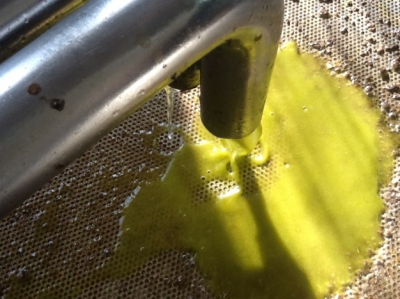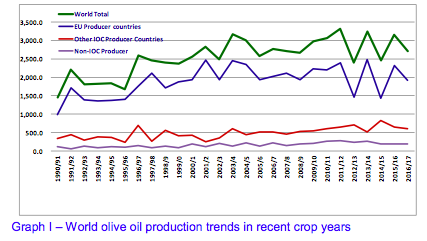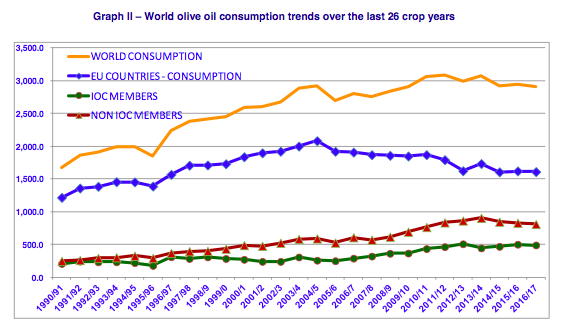
The 2015/16 crop year opened with 277 000 t of olive oil held in world stocks. World production is assessed at 3 159 500 t, up by 29% compared to 2014/15 (+ 701 500 t).
The figure for the aggregate olive oil production of the IOC member countries stands at 2 964 500 t, equal to 94% of the world total. EU olive oil production is assessed at 2 322 000 t, up by 62% year-on-year.
The individual figures show Spain in first place with 1 401 600 t, followed by Italy with 474 600 t, Greece with 320 000 t, Portugal breaking the 100 000 t barrier with 109 100 t, Cyprus with 6 000 t, Croatia with 5 500 t and Slovenia with 500 t. Overall output in the rest of IOC Members fell by 23%.
The leader of the group is Turkey with 143 000 t, followed by Tunisia (140 000 t), Morocco (130 000 t), Algeria (83 500 t at a constant increase), Jordan (29 500 t), Egypt (25 000 t), Lebanon (23000t), Argentina (19000t), Libya (18000t), Israel (15 000 t), Albania (10 500 t) and Iran (5 000 t). Production volumes in the remaining Members are on a smaller scale. Chart I shows the trend in world production, broken down by three producer groups: EU/IOC Members, other IOC Members and non-IOC Members.

World consumption in 2015/16 is provisionally assessed at 2 945 500 t, which is a 1% increase on the season before. The EU-28 consumed 1 618 500 t of this, for an overall increase of 1% (+14 000 t). The countries with the highest increases are Greece with 8% and Spain and Italy with 2% each, and the small producers (Cyprus, Croatia and Slovenia) which together post a 20% increase. Consumption in France however falls by 4%. The consumption figure for the rest of IOC member countries increases by approximately 7%. The biggest increases are seen in Iran (33%), Algeria (25%), Egypt (20%), Tunisia (17%), Libya (16%), Lebanon (11%), Argentina (8%) and Jordan (4%). Decreases are observed in Albania (-4%), Israel (-3%) and Turkey (-1%). The remaining countries post similar consumption rates to the previous crop year. Among the non-IOC Members, notable increases are observed in China (16%), Canada (9%), Russia (3%), the United States and Australia (5% each). Consumption however declined by 25% in Brazil and by 8% in Japan.
Olive oil imports in 2015/16 totalled 822 500 t, while exports came in at 829 500 t.
According to the latest official estimates world olive oil production in 2016/17 is expected to fall by 14%, coming in at around 2 713 500 t. The aggregate output of IOC member countries is estimated at 2 519 000 t. EU producers are expected to account for 1 923 000 t of this tonnage, showing a 17% year-on-year decrease. The breakdown shows production forecasts of 1 311 300 t for Spain (-6%), followed by Greece with 260 000 t (-19%); Italy with 243 000 t (-49%), and Portugal with 93 600 t (-14%). Smaller tonnages are forecast for the rest of EU producers. Elsewhere among the IOC membership, olive oil production is forecast to be 7% lower than in 2015/16. Tunisia would take the biggest hit with a production of 100 000 t (-29%), followed by Morocco with 110 000 t (-15%), Algeria with 74 000 t (-11%), Jordan with 23 000 t (-22%), Lebanon with 20 000 t (-13%), Argentina and Libya with 15 500 t (-18% and -14% respectively). The countries that are forecast to increase their output are Turkey with 177 000 t (+24%), Egypt with 27 000 t (+8%), Israel with 16 000 t (+7%) and Albania with 11 000 t (+5%). The remaining countries present smaller production volumes.

World olive consumption for 2016/17 is forecast at 2 904 000 t, which would be 1% below the last crop year. Graph II illustrates the world consumption trends in three groups of countries: European consumer countries, IOC member countries and non-IOC Members.
Historical time series data (1990/91– 2015/16) for production, consumption, imports and exports of olive oil and table olives can be found at: HERE and HERE
Photo by Luigi Caricato
To comment you have to register
If you're already registered you can click here to access your account
or click here to create a new account


Comment this news